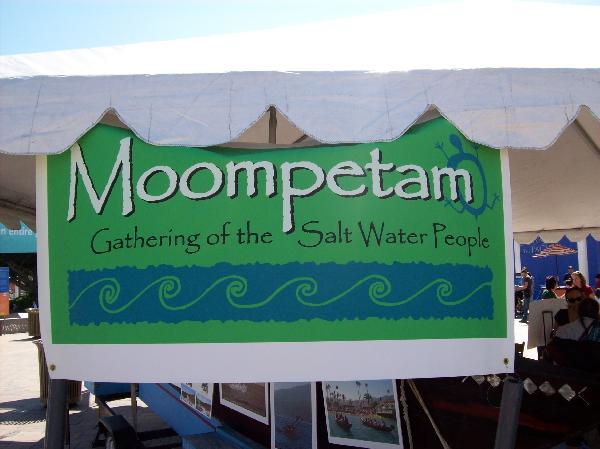On September 20 and 21, Long Beach's Aquarium of the Pacific hosted the fourth annual Native American festival, Moompetam Gathering of the Salt Water People. Moompetam (which means “of the ocean” in Tongva) is comprised of several maritime tribes, including Tongva, Acjachemen, Chumash, Costanoan, and Luiseno.
As one of the speakers at the event pointed out, this was a rare opportunity to experience Native cultures up-close via storytelling, food, one-on-one conversations, music, and workshops.
Indeed, the Rainbow Bridge Story (which explains the arrival of the Chumash onto the mainland) was told to me by two different people. Each telling invoked vivid, yet distinctly different imagery in my mind. Nevertheless, in both cases, the same story was imparted.
Other stories were told throughout the weekend. Some involved villages in Asuksangna (Azusa) , Kuukamonga (Cucamonga), and Puvungna (Long Beach/Los Alamitos), and at least one described interactions among them.
The food samples included elderberries, rose hips, fish, and grasshopper. I felt tempted to try the latter, but 22+ years of being a vegetarian hindered me. The taste was described to me as like over-roasted peanuts, with somewhat of a charcoal-y taste. From my standpoint, the idea of eating local food in the post-carbon world (or just dropping out of this “civilization”) seems slightly less daunting.
Although the event was a celebration, the evil aspects of the past—since the arrival of Europeans to this hemisphere—was not dismissed. Cindi Alvitre, director of the Ti'at Society and one of the hosts of KPFK's American Indian Airwaves, began her lecture, Tongva Maritime Culture, by underscoring the acts of genocide and ethnic cleansing of First People by California's “settlers” and missionaries.
There was discussion of Toypurina, who instigated a revolt against the San Gabriel Mission in 1785. (As some readers know, a monument to her in Baldwin Park mobilized the Minute Men a few years ago--as well as supporters of indigenous rights and NAFTA refugees. See:
http://www.la.indymedia.org/news/2005/06/130745.php.) Additional information about Toypurina can be found at www.haramokngna.org and in the book A Time of Resistance: California Indians During the Mission Period by Sarah Supahan.
Alvitre also showed actual photos from about the late 19th/early 20th century of a young Tongva man before and after his mandatory stay in boarding school. The differences between the two photos were striking. After his assimilation, he looked like a different person, his once-flowing hair reduced to a look reminiscent of Beaver Cleaver (or some other all-American kid).
Alvitre talked about the trauma experienced by today's survivors, mentioning Post Traumatic Stress Disorder and silent knowings. A book that she recommended was Decolonizing Methodologies by Maori professor Linda Tuhiwai Smith.
Despite the horrific past, she underscored positive aspects of the present: the resilience of First People; revivals in basket making, tattoos, and a return of ti'at construction and usage (a ti'at is a canoelike boat which is a very important part of Tongva culture); and ceremonies, like those recently held at L.A.'s Cornfield Park (a pocket of reclaimed Earth surrounded by development, with skyscrapers looming in the background). This former railroad yard was planted with Hopi corn, which leached toxins out of the soil. Alvitre added that once the corn was harvested, the husks remained on the site, piled and arranged into formations referred to as Corn Henge. This remained until nature reclaimed it.
She noted that elsewhere in Southern California, part of Puvungna, a sacred site, remains partly intact on the campus of Cal State Long Beach (more at: www.csulb.edu/~eruyle/puvuhome.html and
http://forum.myspace.com/index.cfm?fuseaction=messageboard.viewThread&entryID=16564773&groupID=100092700&adTopicID=8&Mytoken=41A6066C-BF0E-4C5D-B516053CC45FF49E7172240). However, as Alvitre mentioned, the legal battle to preserve it is ongoing.
Near the end of her talk, Alvitre mentioned the inclusiveness of the Ti'at Society, pointing out that many people in this area now have mixed blood. She said that all of us need to work together to protect Earth.
A ti'at was displayed prominently in front of the Aquarium. It will ply the ocean this coming weekend in Santa Monica during Honoring the Sea, the closing ceremony of the World Festival of Sacred Music. See: www.festivalofsacredmusic.org. Attendees are being asked to dress in white.

